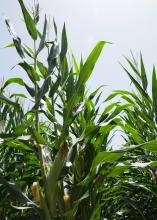Information Possibly Outdated
The information presented on this page was originally released on July 11, 2014. It may not be outdated, but please search our site for more current information. If you plan to quote or reference this information in a publication, please check with the Extension specialist or author before proceeding.
More acres planted in state's major row crops than in 2013
MISSISSIPPI STATE -- Mississippi producers planted more of the state’s major row crops than they planned in March, and the majority of them are in good condition.
Every winter, Mississippi producers estimate how many acres they will plant of each crop they intend to grow. The U.S. Department of Agriculture tabulates these in March and issues the planting intentions report. On June 30, USDA released actual planted acre figures for the state.
Mississippi has 2.25 million acres of soybeans, up 12 percent from 2013 acreage and up 100,000 acres from March intentions. The state has 400,000 acres of cotton, up 38 percent from 2013 and up 20,000 acres from the earlier estimate.
Growers planted 170,000 acres of rice for 2014, up 36 percent from last year and unchanged from March planting intentions. Corn was the only major crop to drop acreage from what was expected in March. The state has 540,000 acres of corn, down 37 percent from 2013 and down 40,000 acres from March intentions.
Brian Williams, agricultural economist with the Mississippi State University Extension Service, said most of the state’s major crops set yield records over the last few years with favorable growing conditions. This encouraged producers to keep acreage high.
“I think the record yields along with favorable markets this spring encouraged producers to plant even more acres of soybeans and cotton this year,” Williams said. “Although prices have come down since planting, it could still be a very good year for many producers.”
Williams said those acreage increases have come at the expense of other crops.
“For example, Mississippi corn acreage was reduced by 40,000 acres from March estimates and hay was reduced by 110,000 acres,” he said.
USDA makes planted acreage estimates by surveying approximately 11,000 parcels of land nationally, each consisting of about 1 square mile. These producers are asked about planted acres on that parcel of land, and results are used to calculate total acreage numbers.
John Michael Riley, Extension agricultural economist, said crop rotation is partially responsible for corn’s drop in acreage and soybean’s increase.
“U.S. producers, primarily those in the Corn Belt, spent three straight years heavily invested in corn and devoted a large amount of acres to the crop largely without rotation,” Riley said. “We saw a small shift away from corn and toward soybeans last year, but this year appears to be a more significant shift.”
While price was the primary driver of this shift, Riley said the need for rotation played a role in getting the record number of soybean acres planted.
Mississippi was not the only state to see increases in the major row crops.
“U.S. producers planted 3.35 million more acres of soybeans than was estimated in the March planting intentions report, and producers in all but two states increased their soybean acres from March intentions,” Williams said. “If the acreage numbers stand, this year’s 84.84 million acres will be the largest U.S. soybean acreage on record.”
U.S. wheat and cotton acres were also increased from March, but corn acres were decreased by 50,000 acres nationally.
The increased acreage nationwide is driving prices down.
“The record acres combined with very positive crop condition reports released each Monday afternoon by the USDA have taken their toll on soybean markets. Corn prices have also taken a hit, with December corn losing 55 cents since the report’s release, although for different reasons,” Williams said.
More corn is stockpiled than previously expected, and this has contributed to lower prices.
Mississippi crops growing on these increased acreages are overall in very good condition at this point in the growing season. By July 6, USDA reported that 70 percent of corn, 71 percent of cotton, 82 percent of rice and 70 percent of soybeans were in good to excellent condition. Just 25 percent or less of each crop was in fair condition, with the remaining acres in poor shape. No acres in the state were listed as very poor.












